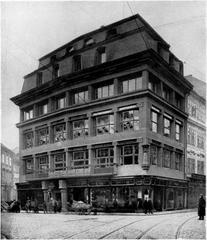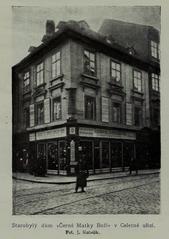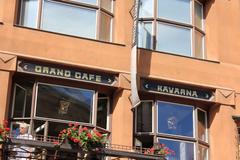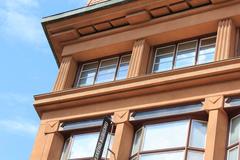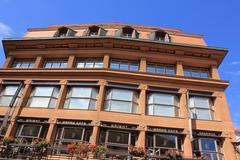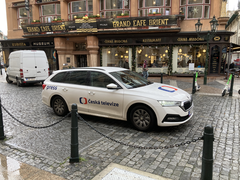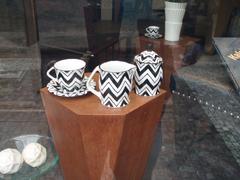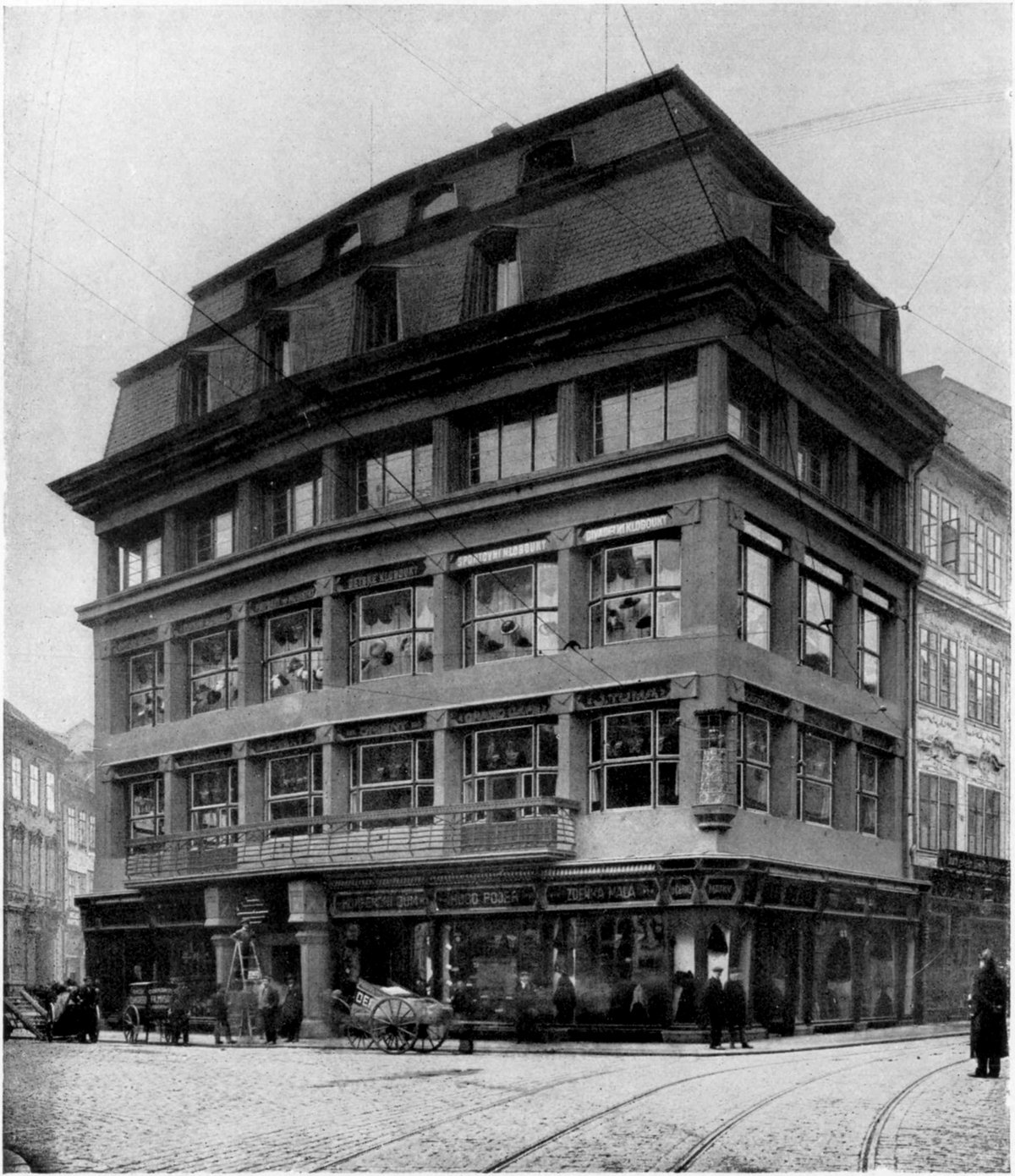
House of the Black Madonna Prague: Visiting Hours, Tickets, and Historical Sites Guide
Date: 14/06/2025
Introduction: A Landmark of Czech Cubism in Prague
Located in the vibrant heart of Prague’s Old Town, the House of the Black Madonna (Dům U Černé Matky Boží) is celebrated as a pioneering example of Czech Cubism and a symbol of early 20th-century architectural innovation. Designed by eminent architect Josef Gočár between 1911 and 1912, this iconic building stands as the world’s first fully Cubist architectural work. Its distinctive geometric façade and the celebrated Grand Café Orient interior provide visitors a rare opportunity to step into a movement that transcended traditional visual arts, impacting architecture, furniture, and everyday design.
Beyond its architectural significance, the House of the Black Madonna reflects the cultural ambitions of early 20th-century Czech society and its search for a modern national identity. Its meticulous restoration in the early 2000s has ensured its survival as a vibrant cultural hub, now housing the Czech Cubism Museum and regularly hosting exhibitions, educational programs, and cultural events. Conveniently situated near major Prague attractions such as the Old Town Square, Powder Tower, and Astronomical Clock, it is an essential stop for anyone interested in Prague’s artistic and architectural heritage (Museum of Decorative Arts in Prague, VisitCzechia, Prague Now).
Table of Contents
- Architectural Context and Origins
- The Emergence and Significance of Czech Cubism
- Structure, Materials, and Design Features
- The Black Madonna Statue: Symbolism and Heritage
- The Grand Café Orient: A Cubist Icon
- Museum of Czech Cubism: Exhibitions and Collection
- Visitor Information
- Nearby Attractions
- Frequently Asked Questions (FAQ)
- Conclusion and Planning Tips
- References and Further Reading
Architectural Context and Origins
The House of the Black Madonna was conceived during a period of dynamic urban renewal in Prague’s Old Town. Designed by Josef Gočár and built between 1911 and 1912, it replaced a Baroque structure, retaining the symbolic Black Madonna statue as a link to the past. Commissioned as a department store for merchant František Josef Herbst, Gočár’s bold Cubist design was a direct response to Prague’s evolving cityscape, artfully integrating modernist ideals with the historic surroundings of Celetná Street and the Fruit Market (visitczechia.com).
The Emergence and Significance of Czech Cubism
Czech Cubism, inspired by French Cubist painting but uniquely extended to architecture, emerged as a short-lived yet influential movement from 1910 to 1920. Architects such as Gočár, Pavel Janák, and Josef Chochol embraced sharp angles, prismatic forms, and crystalline motifs, pushing the boundaries of traditional architecture. The House of the Black Madonna is widely recognized as the first and most significant example of this revolutionary style (Museum of Decorative Arts).
Structure, Materials, and Design Features
A technical marvel of its time, the House of the Black Madonna utilized a reinforced concrete skeleton, allowing for open, pillar-free interiors—most notably in the Grand Café Orient. The façade impresses with angular bay windows, geometric ornamentation, and dynamic projections, while the interior is meticulously detailed with Cubist motifs, from stair railings to wrought-iron chandeliers and custom furnishings (Prague Now). These design elements, purely decorative in their angularity, enhance the building’s visual drama and reinforce its Cubist identity.
The Black Madonna Statue: Symbolism and Heritage
The building’s name derives from the Baroque Black Madonna statue, dating to around 1700. Preserved from the previous structure and installed on the new building’s north-east corner, this statue symbolizes Prague’s deep historical roots and bridges the gap between the city’s spiritual heritage and its modern aspirations (Museum of Decorative Arts).
The Grand Café Orient: A Cubist Icon
Occupying the first floor, the Grand Café Orient is the world’s only surviving Cubist café, restored to its 1912 design using original plans and photographs. Architect Josef Gočár designed every detail, from furniture to light fixtures. The café’s open, light-filled space, free of supporting pillars, is a marvel of early 20th-century engineering and design. Visitors can enjoy coffee, tea, and pastries—including the signature square ‘venecek’—in a unique Cubist setting (Cheryl Howard; Delve Into Europe).
Museum of Czech Cubism: Exhibitions and Collection
The Museum of Czech Cubism, located on the second and third floors, is the only museum in the world dedicated exclusively to Cubism in architecture and applied arts. Its exhibitions feature:
- Original and replica Cubist furniture by Gočár, Janák, and Chochol
- Paintings and sculptures by Emil Filla, Bohumil Kubišta, Josef Čapek, and Otto Gutfreund
- Cubist ceramics and glassware, including Janák’s iconic twelve-faced tea sets
- Multimedia and interactive displays illuminating the history and influence of Czech Cubism (Prague.cz; View from Prague)
Visitor Information
Location and Accessibility
- Address: Ovocný trh 19, 110 00 Praha 1, Staré Město, Czechia (View from Prague)
- Getting There: A short walk from Old Town Square, near Náměstí Republiky (Metro Line B). The area is pedestrian-friendly, and nearby tram and metro stations offer easy access.
Visiting Hours
- Tuesday–Sunday: 10:00 AM – 6:00 PM (last entry 5:30 PM)
- Monday: Closed
- Closed on: Select public holidays (January 1, Easter Monday, May 1 and 8, July 5 and 6, October 28, December 24–26) (Prague Guide)
Ticket Prices
- Adults: 100–250 CZK (check the official site for current rates)
- Students/Seniors: 80–150 CZK
- Children under 6: Free
- Family Ticket: 150 CZK (varies by exhibition)
- Guided Tours: Available in Czech and English; book via the museum or in advance (Prague Now)
Facilities and Accessibility
- Elevators: Serve all public floors, making the building wheelchair accessible
- Café and Restaurant: Grand Café Orient (first floor); ground-floor restaurant with Cubist décor
- Shop: Modernista-operated, selling quality replicas of Cubist ceramics, glass, and furniture (Prague Now)
- Toilets and cloakroom: Available on site
Guided Tours and Travel Tips
- Best Times to Visit: Weekday mornings or late afternoons
- Photography: Allowed in most areas (no flash or tripods in exhibitions)
- Themed Tours: Cubist and Art Nouveau walking tours often start here
- Special Needs: Contact the museum for specific assistance or to arrange accessible visits
Special Events and Temporary Exhibitions
The museum hosts rotating exhibitions, cultural events, and workshops. Check the official website for current programs.
Nearby Attractions
- Old Town Square: Home to the Astronomical Clock and Týn Church
- Estates Theatre: Historic opera venue
- Powder Tower (Prašná brána): Medieval Gothic gate
- Municipal House (Obecní dům): Art Nouveau concert and exhibition center (Delve Into Europe)
Frequently Asked Questions (FAQ)
Q: What are the visiting hours?
A: Tuesday–Sunday, 10:00 AM–6:00 PM; closed Mondays and select holidays.
Q: How much are tickets?
A: Adult admission ranges from 100–250 CZK; family and concession tickets are available.
Q: Is the building accessible for visitors with limited mobility?
A: Yes, with elevators to all public floors.
Q: Are guided tours available?
A: Yes, in multiple languages; check schedules and book in advance.
Q: Can I take photographs?
A: Yes, except where otherwise noted; flash and tripods may be restricted.
Conclusion and Planning Tips
The House of the Black Madonna is an essential destination for anyone interested in architecture, design, or Prague’s rich history. Its striking Cubist façade, unique museum collections, and the Grand Café Orient provide an immersive cultural experience. Thanks to its central location, accessibility, and visitor amenities, it’s easy to include the House of the Black Madonna in your Prague itinerary.
For the most up-to-date information, check the official website before your visit. Don’t miss the chance to explore this extraordinary fusion of tradition and innovation in one of Europe’s most beautiful cities.
Explore More
Download the Audiala App
Plan your visit and access exclusive content, guided tours, and real-time updates about the House of the Black Madonna and other Prague historical sites. Follow us on social media for news, events, and inspiration.
References and Further Reading
- Visiting the House of the Black Madonna in Prague: Hours, Tickets, and History, 2025, VisitCzechia (VisitCzechia)
- House of the Black Madonna in Prague: Visiting Hours, Tickets, and Architectural Highlights, 2025, Prague Now (Prague Now)
- House of the Black Madonna in Prague: Visiting Hours, Tickets, and Cultural Significance, 2025, Prague Guide (Prague Guide)
- Exploring the House of the Black Madonna: Visiting Hours, Tickets, and Prague Historical Sites, 2025, View from Prague (View from Prague)
- Museum of Decorative Arts in Prague – The House at the Black Madonna, 2025 (Museum of Decorative Arts in Prague)
- National Gallery Prague – House of the Black Madonna, 2025 (National Gallery Prague)
